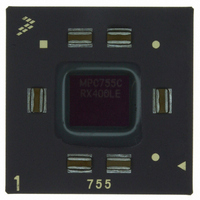MPC755CRX400LE Freescale Semiconductor, MPC755CRX400LE Datasheet - Page 44

MPC755CRX400LE
Manufacturer Part Number
MPC755CRX400LE
Description
IC MPU 32BIT 400MHZ PPC 360-CBGA
Manufacturer
Freescale Semiconductor
Datasheet
1.MPC755BPX300LE.pdf
(56 pages)
Specifications of MPC755CRX400LE
Processor Type
MPC7xx PowerPC 32-Bit
Speed
400MHz
Voltage
2V
Mounting Type
Surface Mount
Package / Case
360-FCCBGA
Family Name
MPC7xx
Device Core
PowerPC
Device Core Size
64b
Frequency (max)
400MHz
Instruction Set Architecture
RISC
Supply Voltage 1 (typ)
2V
Operating Supply Voltage (max)
2.1V
Operating Supply Voltage (min)
1.9V
Operating Temp Range
0C to 105C
Operating Temperature Classification
Commercial
Mounting
Surface Mount
Pin Count
360
Package Type
FCCBGA
Lead Free Status / RoHS Status
Contains lead / RoHS non-compliant
Features
-
Lead Free Status / Rohs Status
Not Compliant
Available stocks
Company
Part Number
Manufacturer
Quantity
Price
Company:
Part Number:
MPC755CRX400LE
Manufacturer:
MOT
Quantity:
12 388
Company:
Part Number:
MPC755CRX400LE
Manufacturer:
Freescale Semiconductor
Quantity:
10 000
System Design Information
There is no standardized way to number the COP header shown in
pin numbers have been observed from emulator vendors. Some are numbered top-to-bottom then
left-to-right, while others use left-to-right then top-to-bottom, while still others number the pins counter
clockwise from pin 1 (as with an IC). Regardless of the numbering, the signal placement recommended in
Figure 25
The QACK signal shown in
input to the MPC755 informing it that it can go into the quiescent state. Under normal operation this occurs
during a low-power mode selection. In order for COP to work, the MPC755 must see this signal asserted
(pulled down). While shown on the COP header, not all emulator products drive this signal. If the product
does not, a pull-down resistor can be populated to assert this signal. Additionally, some emulator products
implement open-drain type outputs and can only drive QACK asserted; for these tools, a pull-up resistor
can be implemented to ensure this signal is deasserted when it is not being driven by the tool. Note that the
pull-up and pull-down resistors on the QACK signal are mutually exclusive and it is never necessary to
populate both in a system. To preserve correct power-down operation, QACK should be merged via logic
so that it also can be driven by the PCI bridge.
8.8
This section provides thermal management information for air-cooled applications. Proper thermal control
design is primarily dependent on the system-level design—the heat sink, airflow, and thermal interface
material. To reduce the die-junction temperature, heat sinks may be attached to the package by several
methods—adhesive, spring clip to holes in the printed-circuit board or package, and mounting clip and
screw assembly; see
Figure 25
44
Thermal Management Information
is common to all known emulators.
describes the package exploded cross-sectional view with several heat sink options.
Figure 25. Package Exploded Cross-Sectional View with Several Heat Sink Options
Figure
Thermal Interface Material
MPC755 RISC Microprocessor Hardware Specifications, Rev. 8
25. This spring force should not exceed 5.5 pounds (2.5 kg) of force.
Figure 24
Heat Sink
Heat Sink
Adhesive or
is usually connected to the PCI bridge chip in a system and is an
Clip
Printed-Circuit Board
CBGA Package
Figure
24; consequently, many different
Option
Freescale Semiconductor












